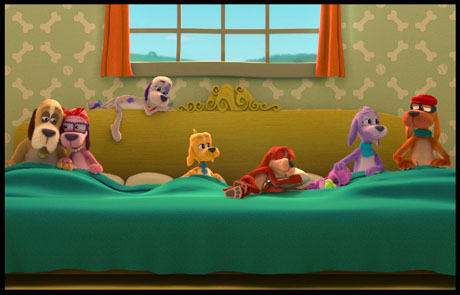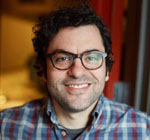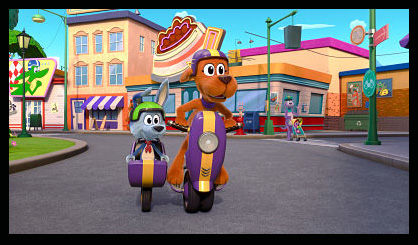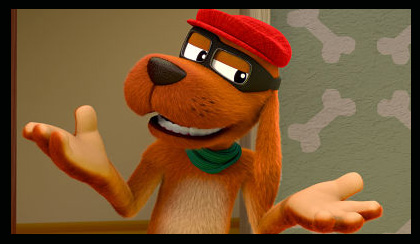
Exactly 60 years after the release of the iconic book Go, Dog. Go!, DreamWorks and WildBrain have teamed-up for a new TV show adaptation, premiering this Tuesday January 26th on Netflix. Executive Producer Adam Peltzman is honored to shepherd this project and shares behind the scenes details on creating the stories, characters and town of… Pawston.
Adam Peltzman: We’ve had the chance to collaborate with Random House and the Eastmans. They’ve weighed in on the scripts and have been really supportive. It’s totally an honor to work on a show that’s based on a book that has meant a lot to so many kids over the years… and parents. It’s really exciting.

Jackson Murphy: I remember reading it when I was young. Were there any specific requests from the Eastman estate?
AP: They read everything and they watched everything, and they weighed in with notes. I can’t remember any big standout issues or critiques. For the most part they seemed to really enjoy the stories. It’s a tough thing because it’s lived as a book for so long. I give them a lot of credit to being open and flexible to seeing how it adapts to a show format. They’ve been nothing but supportive.
JM: That’s great to hear. I love the opening shot in the first episode, which is all the dogs in the same bed. It’s a fun, cute way to get you into the mindset. How important is this sense of family bonding over the course of the series?

Adam Peltzman
JM: You talk about community and all the different dogs. How do you keep track of all of the different dogs you’ve designed?
AP: I guess that’s the pleasure of working with a really great art team. They have the task of trying to create dogs that are reminiscent of the book and the P.D. Eastman style, but we also branched away from that and created designs that were unique to this world and to the show. We would write a script and really get a sense of the personality of the dog involved. That was always a great challenge for the art team to create a character that reflected that personality. I hope it feels like a cohesive world of dogs but there’s a lot of diversity within it in terms of designs and personalities.
JM: And I love the town center. And in the first episode, all of the dogs are howling in a traffic jam. I feel like that’s what all of us would want to do. We get so angry that we howl and bark. You capture that very well.
AP: Thank you very much. Obviously the Pilot, more than any other episode, pulled things directly from the book: the big party in the tree and the big traffic jam. Some of those iconic moments and scenes were fun to play out in the show.

JM: Tag and Scooch are fast friends. Right away. Why do you think they connect so well so quickly?
AP: A lot of that’s about Tag’s personality. She jumps right in. She doesn’t miss a beat and goes on instinct and has this community theme. She has such a pride for her town / neighborhood / community that it’s just second nature to her to welcome somebody right in. The fact that Scooch didn’t have any friends or know anybody yet made her more driven to pull him in. For Scooch, he’s an easygoing kid who’s not particularly assertive or adventurous. He needs a little bit of that push to get out into the world and to experience things.
JM: When Lady Lydia asks if certain characters like her hats, the responses are very honest, which is something nice for kids to learn: being honest while still being nice.
AP: The “Do You Like My Hat?” is so iconic from the book, and I definitely wanted to include it in the show. It felt like it’d be truer to the book if they didn’t always like her hat. And sometimes they do. It felt a little funny at first to put a negative sentiment into the mouth of our main character. We want kids to be respectful. We tried to handle that moment truthfully and politely and respectfully. And the thing about Lady Lydia is: she loves her hats. She just likes to ask if you like them. Whether you like them or not, she’s completely fine and unphased.
JM: Of course one of the other key components of this series is the vehicles. How do you decide where, when and how to use them?
AP: It’s how everybody gets around. It’s a town on the go. In the same way that there’s a fun, creative diversity of dogs, there’s a fun challenge in creating different vehicles that match the personalities of the dogs. Tag has her fast scooter that she can alter to make do whatever she needs to do. Scooch is either in the sidecar or has his slower tractor back from his farm days. It’s a comedic adventure show and it’s a character driven adventure show. The coolness of the vehicles is part of it, but the fun and personalities of those vehicles is more what drives the series.
JM: Drives the series. That’s a good pun.
AP: Oh, yeah. Wow. That is good.

JM: Your animation credits are fantastic – some of the most popular and beloved animated shows of the past 25 years, like Blue’s Clues, The Octonauts, Peter Rabbit and The Backyardigans. What have you noticed change and stay the same in terms of the animation world over the past 25 years?
AP: That is a good question. I guess the biggest change in recent years is… there’s so many more outlets now with streaming. It used to be that there were a couple major networks or cable networks and you kind of knew if a show launched on one of those networks – it would get a certain kind of audience. Now it’s pretty exciting because the show finds its audience. The audience seeks out that show. It’s allowed for a wider variety of kinds of shows and maybe some more originality and the types of shows that don’t have to appeal to absolutely everybody but will really find a passionate audience. So hopefully this will be one of those.
JM: I think it will be. This show is ready to be unleashed in a brand new year. What does it mean to you to have gotten through production on this season through one of the most unpredictable years ever… for the animation world – and now putting this out for families to enjoy in 2021?
AP: It means a lot. When COVID hit, there was so much uncertainty. We were right in the middle of our production process. There were real questions of how it would affect things. And it certainly did in the sense that many of our artists and animators and team had to be working remote. But I just give so much credit to the team for adjusting. This show is a co-production between DreamWorks and WildBrain. Those two companies work so well together, and then within the companies, the various artists and animators and everybody across the board had to adjust. They kept doing great work. It’s really impressive and I think it shows in the end product. I’m just really proud of the team for the way they adapted to a tough situation.
- INTERVIEW: Jeff Fowler On “Knuckles” And “Sonic 3” - April 22, 2024
- INTERVIEW: “Inside Out 2” Director And Producer On Pixar Sequel - April 16, 2024
- INTERVIEW: “Puffin Rock And The New Friends” And 25 Years Of Cartoon Saloon - April 10, 2024


 January 21st, 2021
January 21st, 2021  Jackson Murphy
Jackson Murphy  Posted in
Posted in  Tags:
Tags: 






